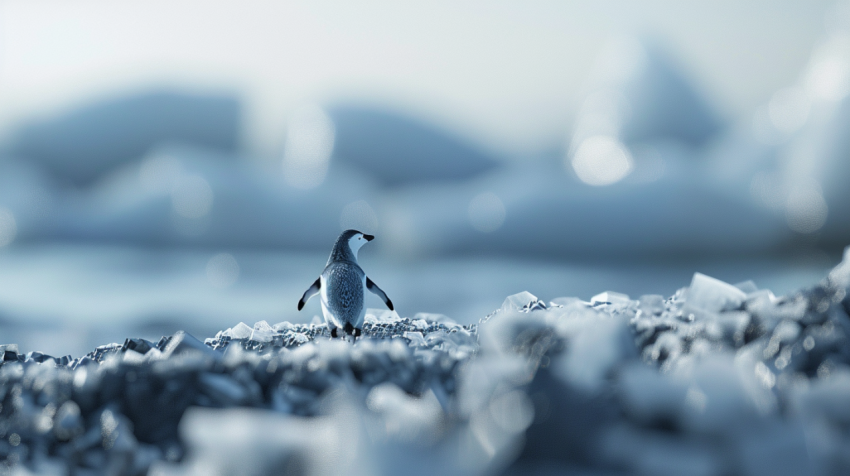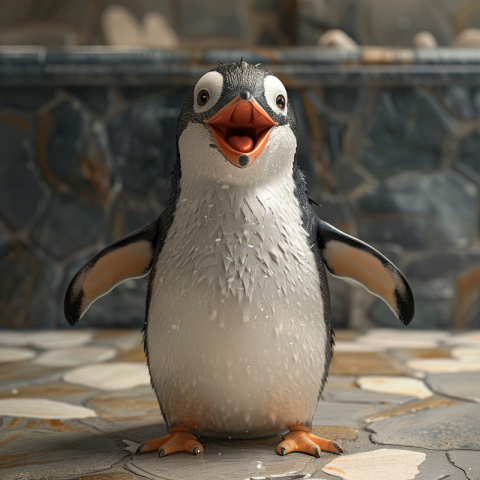











Penguins: Flightless Wonders of the Southern Hemisphere
Penguins, with their tuxedo-like plumage, waddling gait, and remarkable adaptations to aquatic life, are among the most beloved and recognizable birds on Earth. These flightless wonders of the Southern Hemisphere have captured the human imagination, becoming symbols of resilience, adaptability, and the unique beauty of polar environments. This comprehensive guide will delve into the captivating world of penguins, exploring their evolutionary history, diverse species, physical characteristics, remarkable adaptations to cold and aquatic environments, breeding behaviors, diet, the threats they face, and ongoing conservation efforts.
What Defines a Penguin?
Penguins belong to the family Spheniscidae and are a group of aquatic, flightless birds. They are highly specialized for life in the water and are found almost exclusively in the Southern Hemisphere.
Key Characteristics of Penguins:
- Flightlessness: Penguins are unique among birds in that they have lost the ability to fly. Their wings have evolved into flippers, making them powerful swimmers.
- Streamlined Bodies: Penguins have streamlined, torpedo-shaped bodies that reduce drag in the water, allowing for efficient swimming.
- Dense Plumage: They have a dense layer of overlapping feathers that provides insulation and waterproofing.
- Countershading: Penguins exhibit countershading, with black backs and white bellies. This coloration provides camouflage from predators both above and below the water.
- Solid Bones: Unlike most birds, which have hollow bones to reduce weight for flight, penguins have solid, dense bones that help them stay submerged while swimming and diving.
- Specialized Feet: Penguins have webbed feet that are used for steering in the water and for propulsion on land.
- Salt Glands: Penguins possess specialized salt glands above their eyes that allow them to excrete excess salt from the seawater they consume.
Evolutionary History:
- Ancient Origins: The earliest penguin ancestors likely evolved from flying birds around the time of the extinction of the dinosaurs, approximately 66 million years ago.
- Adaptation to Aquatic Life: Over millions of years, penguins gradually adapted to an aquatic lifestyle, losing the ability to fly and developing specialized features for swimming and diving.
- Fossil Record: The fossil record of penguins is relatively rich, with many extinct species having been discovered, some of which were much larger than any living penguin species today.
Diverse Penguin Species:
There are 18 recognized species of penguins, exhibiting a range of sizes, appearances, and adaptations. Some notable examples include:
- Emperor Penguin (Aptenodytes forsteri): The largest living penguin species, the Emperor Penguin is renowned for its incredible breeding cycle on the Antarctic sea ice during the harsh winter.
- King Penguin (Aptenodytes patagonicus): The second-largest penguin species, the King Penguin is found on subantarctic islands and has a distinctive orange patch on its neck.
- Gentoo Penguin (Pygoscelis papua): Recognizable by the white stripe across its head, the Gentoo Penguin is known for its speed and agility in the water.
- Adélie Penguin (Pygoscelis adeliae): A small, feisty penguin found along the Antarctic coast, the Adélie Penguin is known for its black head and white eye-ring.
- Chinstrap Penguin (Pygoscelis antarcticus): Named for the thin black band under its chin, the Chinstrap Penguin is found on the Antarctic Peninsula and surrounding islands.
- Little Penguin (Eudyptula minor): Also known as the Fairy Penguin, this is the smallest penguin species and is found along the coasts of Australia and New Zealand.
- Galápagos Penguin (Spheniscus mendiculus): The only penguin species found north of the equator, the Galápagos Penguin is adapted to the warmer waters of the Galápagos Islands.
- Humboldt Penguin (Spheniscus humboldti): Found along the Pacific coast of South America, the Humboldt Penguin is threatened by overfishing and habitat loss.
- Magellanic Penguin (Spheniscus magellanicus): This penguin breeds along the coasts of Argentina, Chile, and the Falkland Islands and migrates north during the winter.
Habitat and Distribution:
- Southern Hemisphere: Penguins are found almost exclusively in the Southern Hemisphere, with the majority of species inhabiting Antarctic and subantarctic regions.
- Coastal Environments: Penguins are primarily coastal birds, spending much of their lives at sea and coming ashore to breed and molt.
- Range of Habitats: Different penguin species are adapted to a range of habitats, from the icy landscapes of Antarctica to the temperate forests of New Zealand and the arid coasts of South America.
Adaptations to Cold and Aquatic Environments:
Penguins have evolved a suite of remarkable adaptations that allow them to thrive in cold and aquatic environments:
- Insulation:
- Blubber: Penguins have a thick layer of blubber (fat) beneath their skin that provides insulation in cold water.
- Dense Plumage: Their dense, overlapping feathers trap a layer of air, providing further insulation and waterproofing.
- Efficient Swimming:
- Flippers: Their wings have evolved into stiff, paddle-like flippers that are highly efficient for underwater propulsion.
- Streamlined Body: Their torpedo-shaped bodies reduce drag, allowing them to swim quickly and efficiently.
- Solid Bones: Their dense bones help them overcome buoyancy and dive to considerable depths.
- Diving: Penguins are exceptional divers. Some species, like the Emperor Penguin, can dive to depths of over 1,800 feet (550 meters) and hold their breath for over 20 minutes.
- Countershading: As mentioned earlier, their black and white coloration provides camouflage in the water.
Diet and Feeding:
Penguins are carnivores, feeding primarily on:
- Krill: Small, shrimp-like crustaceans that are abundant in Antarctic waters. Krill is a major food source for many penguin species.
- Fish: Various species of fish, such as anchovies, sardines, and cod, are also important components of the penguin diet.
- Squid: Squid are another significant prey item for many penguins.
- Hunting Techniques: Penguins are pursuit divers, chasing down their prey underwater. Their speed and agility, combined with their sharp beaks, make them effective hunters.
Breeding and Nesting:
- Colonial Breeders: Most penguin species are colonial breeders, gathering in large groups called rookeries or colonies to breed and raise their young.
- Breeding Sites: Breeding sites vary by species but are typically located on land, near the coast. Some species, like the Emperor Penguin, breed on sea ice.
- Courtship Displays: Penguins engage in various courtship displays, which may involve vocalizations, head and flipper waving, and bowing.
- Nest Building: Some penguins, like the Gentoo and Adélie, build nests out of stones. Others, like the Emperor and King Penguins, do not build nests but incubate their egg on their feet.
- Egg Laying: Most penguin species lay one or two eggs.
- Incubation: Both parents typically share incubation duties, taking turns keeping the egg(s) warm. In Emperor Penguins, the male incubates the single egg on his feet for about two months during the harsh Antarctic winter while the female is at sea feeding.
- Chick Rearing: Penguin chicks are covered in downy feathers when they hatch. Both parents feed the chicks regurgitated food. Chicks are often left in crèches (groups of chicks) while the parents are foraging.
- Fledging: The time it takes for chicks to fledge (become independent) varies by species, ranging from a few weeks to several months.
Threats to Penguins:
Penguins face a number of threats, both natural and human-induced:
- Climate Change: Climate change is a major threat to many penguin species, particularly those that rely on sea ice for breeding and foraging. Changes in sea ice extent and duration can affect the availability of krill and other prey.
- Overfishing: Overfishing of krill, fish, and squid can reduce the availability of food for penguins.
- Pollution: Oil spills and other forms of marine pollution can harm penguins directly and contaminate their food sources.
- Habitat Loss and Degradation: Coastal development and other human activities can destroy or degrade penguin breeding and foraging habitats.
- Introduced Predators: Introduced predators, such as rats, cats, and dogs, can prey on penguin eggs, chicks, and even adults, particularly on islands where penguins have not evolved alongside such predators.
- Disease: Outbreaks of disease can impact penguin populations, especially in densely populated colonies.
- Human Disturbance: Tourism and research activities can disturb penguin colonies if not managed carefully.
Conservation Efforts:
- Protected Areas: Establishing and managing marine protected areas (MPAs) can help protect penguin foraging grounds and breeding sites.
- Fisheries Management: Implementing sustainable fishing practices that take into account the needs of penguins and other predators is crucial.
- Climate Change Mitigation: Reducing greenhouse gas emissions to mitigate climate change is essential for the long-term survival of many penguin species.
- Pollution Control: Preventing and cleaning up oil spills and other forms of marine pollution can help protect penguins and their habitats.
- Predator Control: Controlling or eradicating introduced predators on islands can help protect penguin colonies.
- Research and Monitoring: Ongoing research and monitoring programs are needed to track penguin populations, understand the threats they face, and evaluate the effectiveness of conservation measures.
- Public Awareness: Raising public awareness about the conservation needs of penguins can help garner support for their protection.
Conclusion:
Penguins are truly remarkable birds that have adapted to some of the harshest environments on Earth. Their unique adaptations to cold and aquatic life, their diverse species, and their complex social behaviors make them a source of endless fascination. However, they also face increasing threats from human activities, particularly climate change. By understanding the challenges they face and supporting conservation efforts, we can help ensure that these flightless wonders of the Southern Hemisphere continue to thrive for generations to come. Their presence in the world is a reminder of the interconnectedness of life and the importance of protecting the planet's biodiversity.
Penguin, Types of Penguins, Penguin Species, Penguin Facts, Emperor Penguin, King Penguin, Gentoo Penguin, Adélie Penguin, Chinstrap Penguin, Little Penguin, Galápagos Penguin, Humboldt Penguin, Magellanic Penguin, Penguin Adaptations, Penguin Habitat, Penguin Diet, Penguin Breeding, Penguin Chicks, Penguin Feathers, Penguin Swimming, Penguin Diving, Penguin Conservation, Are Penguins Endangered, Threats to Penguins, Penguin Pictures, Penguin Videos, Penguin Sounds, Where Do Penguins Live, What Do Penguins Eat, Penguin Lifespan, Penguin Predators, Penguin Colonies, Penguin Rookeries, Flightless Birds, Antarctica, Southern Hemisphere.

